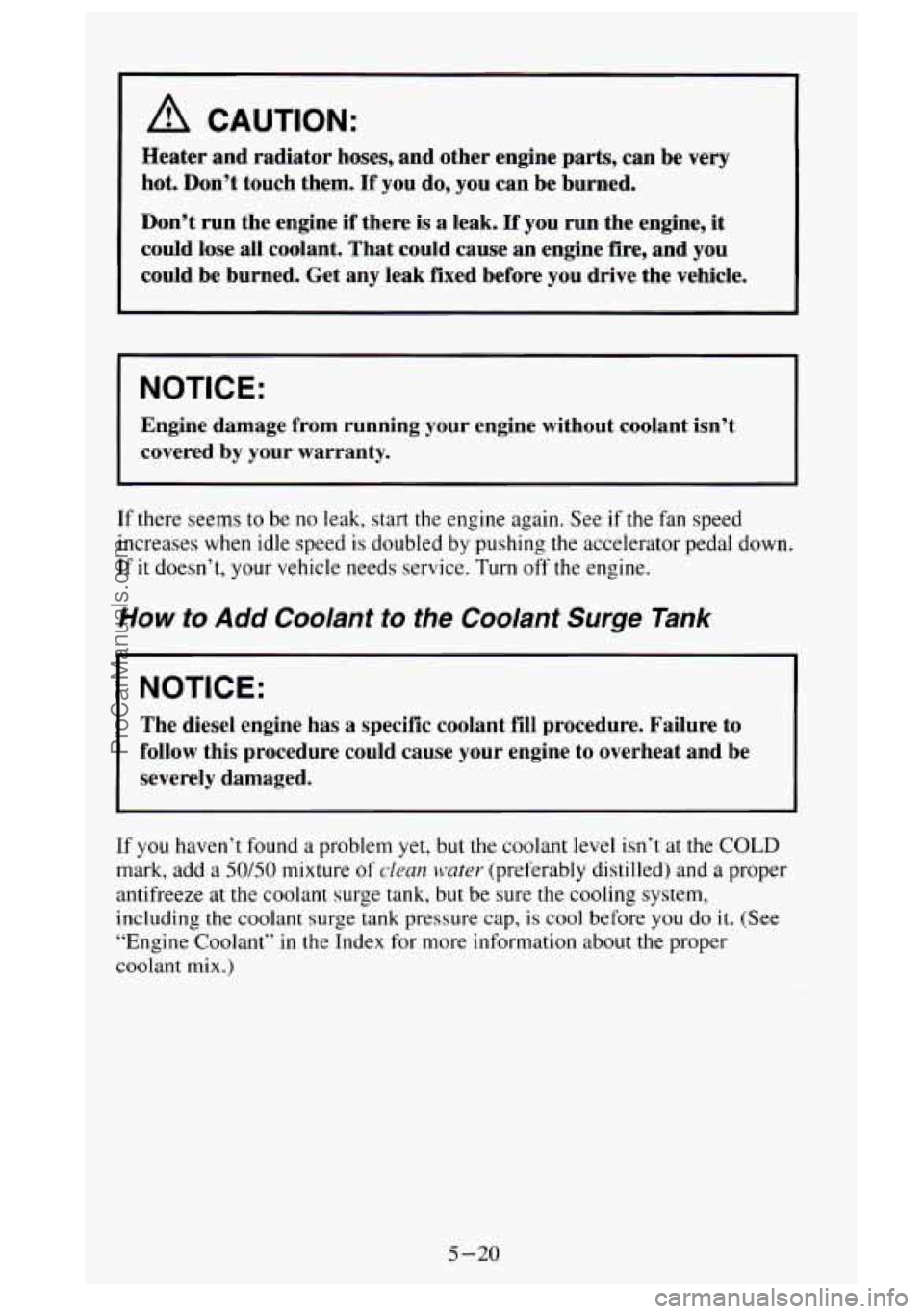Page 236 of 488
Cooling System - Gasoline Engines
When you decide it’s safe to lift the hood, here’s what you’ll see:
A. Coolant recovery tank
B. Engine fan(s)
C. Radiator pressure cap
I A CAUTION:
If your vehicle has air conditioning, the auxiliary electric fan
under the hood can start up even when the engine is not runn\
ing
and can injure you. Keep hands, clothing and tools away from any underhood electric fan.
If the coolant inside the coolant recovery tank is boiling, don’t do anything
else
until it cools down.
5-12
ProCarManuals.com
Page 239 of 488
When the coolant in the coolant recovery tank is at or above the COLD
mark. start your vehicle.
If the overheat warning continues, there’s one more thing you can try. You
can add
the proper coolant mix directly to the radiator, but be sure the
cooling system
is cool before you do it.
A CAUTION:
Steam and scalding liquids from a hot cooling system can blow
out and burn you badly. They are under pressure, and if you
turn the radiator pressure cap
- even a little - they can come
out
at high speed. Never turn the cap when the cooling system,
including the radiator pressure cap, is hot. Wait for the cool\
ing
system and radiator pressure cap to cool if you ever have to turn
the pressure cap.
5- 15
ProCarManuals.com
Page 240 of 488
How to Add Coolant to the Radiator
r
1.
I
You can remove the radiator pressure cap when the cooling system,
including the radiator pressure cap
and upper radiator hose, is no longer
hot. Turn the pressure cap slowly
to the left until it first stops. (Don't
press down while turning the pressure cap.)
If you hear a hiss, wait for that to stop. A hiss means there is still some
pressure left.
:_. .w 2. Then keep
turning the
pressure cap, but
now push down
as you turn it.
Remove the
pressure cap.
5-16
ProCarManuals.com
Page 241 of 488
3. Fill the radiator
with the proper
mix, up to the
base
of the filler
neck.
4. Then fill the
IL
A
I
coolant recovery
tank to the COLD
mark.
5. Put the cap back
on the coolant
recovery tank, but
leave the
radiator pressure
cap
off.
5-17
ProCarManuals.com
Page 242 of 488
F
6. Start the engine
and let it run
until
you can feel the
upper radiator
hose getting hot.
Watch out for the
engine fan(s).
7. By this time the coolant level inside the radiator filler neck may be
lower.
If the level is lower, add more of the proper mix through the
filler neck until the level reaches the base
of the filler neck.
I_
8. Then replace the pressure cap. At any time during this procedure if
coolant begins
to flow out of the filler neck, reinstall the pressure cap.
Be sure the arrows
on the pressure cap line up like this.
5-18
ProCarManuals.com
Page 243 of 488
Cooling System - Diesel Engines
When you decide it‘s safe to lift the hood, here’s what you’ll see:
A. Coolant surge tank pressure cap
B. Engine fan(s)
C. Radiator
A CAUTION:
If your vehicle has air conditioning, the auxiliary electric fan
under the hood can start up even when the engine is not running
and can injure you. Keep hands, clothing and tools away from
any underhood electric fan.
If the coolant inside the coolant surge tank is boiling, don’t do anything else
until it cools down.
The coolant level
should be
at or above
the
COLD mark. If it
isn’t,
you may have a
leak in the radiator
hoses, heater hoses,
radiator, water pump
or somewhere else in
the cooling system.
5-19
ProCarManuals.com
Page 244 of 488

I A CAUTION:
Heater and radiator hoses, and other engine parts, can be very
hot. Don’t touch them.
If you do, you can be burned.
Don’t run the engine
if there is a leak. If you run the engine, it
could lose all coolant. That could cause an engine
fire, and you
could be burned. Get any leak fixed before you drive the vehicle.
I NOTICE:
Engine damage from running your engine without coolant isn’t
covered by your warranty.
If there seems to be no leak, start the engine again. See if the fan speed
increases when idle speed
is doubled by pushing the accelerator pedal down.
If
it doesn’t, your vehicle needs service. Turn off the engine.
How to Add Coolant to the Coolant Surge Tank
I NOTICE:
The diesel engine has a specific coolant fill procedure. Failure to
follow this procedure could cause your engine to overheat and be
severely damaged.
If you haven’t found a problem yet, but the coolant level isn’t at the COLD
mark, add a
50/50 mixture of cleun water (preferably distilled) and a proper
antifreeze at the coolant surge tank, but be sure the cooling system,
including the
coolant surge tank pressure cap, is cool before you do it. (See
“Engine Coolant”
in the Index for more information about the proper
coolant mix.)
5-20
ProCarManuals.com
Page 246 of 488
NOTICE:
In cold weather, water can freeze and crack the engine, radiator,
heater core and other parts.
So use the recommended coolant.
A CAUTION:
You can be burned if you spill coolant on hot engine parts.
Coolant contains ethylene glycol and it will burn if the engine
parts are hot enough. Don't spill coolant on
a hot engine.
1. You can remove the coolant surge tank pressure cap when the cooling
system, including the coolant surge tank pressure cap and upper
radiator hose,
is no longer hot. Turn the pressure cap slowly to the left
until it first stops. (Don't press down while turning the pressure cap.)
If you hear a hiss, wait for that to stop. A hiss means there is still some
pressure left.
5-22
ProCarManuals.com